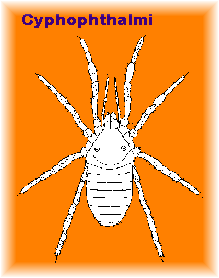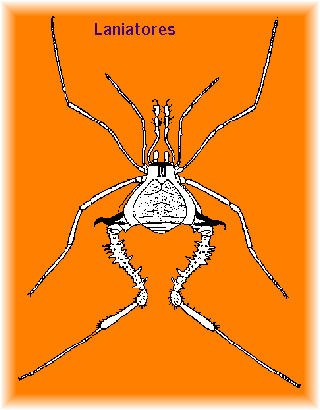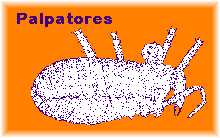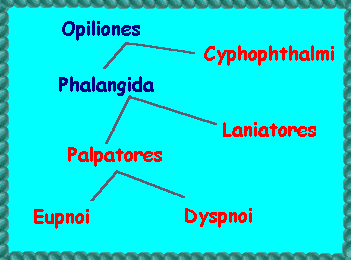 Back to Opiliones Notes
Back to Opiliones Notes Back to Opiliones Notes
Back to Opiliones Notes |
Back to Classification
Page |
In line with many modern texts of invertebrate zoology, I have used the name "Opiliones" to refer to the harvest-spiders, for example in the title for this set of web pages: Opiliones Notes.
But in other places I have used the name "Phalangida" for these creatures; thus my Ph.D. thesis was called Fine Structural Studies on the Eyes of Phalangida.
So just what is the difference between Opiliones and Phalangida - or are they the same?
If you look it up in a textbook of invertebrate zoology, you are likely
to (a) get the impression that Opiliones and Phalangida are synonymous
terms and (b) learn that the order comprises three sub-orders:
Cyphophthalmi, a few species of small, mite-like animals which
live in soil and leaf mould. Their pedipalps are like miniature legs. Note
that some of these opilionids have no eyes (hence their name?).

Laniatores , which usually live in leaf mould in the tropics. Larger in size than the previous sub-order, these arachnids have their pedipalps modified into raptorial appendages which can grasp the prey by folding like a jack-knife; quite often these palps are armed with strong spines. Their legs may be short or long.
Palpatores, the "common or garden" daddy-long-legs, so-called
because of their extremely long legs which feature prominently in their
biology (as locomotion, prey capture, sensory organs).
Our favourite, Mitopus morio, belongs to this group and is portrayed
at the top of this page as the "Back to Opiliones Notes" button, but the
drawing here shows a little more detail of a generalised palpatoran
with its legs removed so that you can see the shape of its body. Note the
prominent eyes on the ocularium sticking up from the animal's back and
the pincer-like chelicerae pointing downwards at the front end, with he
leg-like palp just outside.

So far, so good - but read on...
Over the years, the relative positions of these three sub-orders in relation to each other have shifted according to different authors and how they have interpreted comparative data, often anatomical.
So, to cut a long story short let's just say that in more recent times,
phylogenetic studies have shown that the Opiliones is best considered to
contain two sister groups - the Cyphophthalmi and the Phalangida,
with the latter group comprising the Laniatores and Palpatores.
A good coverage of these taxonomic aspects in terms of modern assessments
based on analysis of nucleotide sequence can be found in the paper by Jeffrey
W. Shultz & Jerome C. Regier: Phylogenetic analysis of Phalangida (Arachnida,
Opiliones) using two nuclear protein-encoding genes supports monophyly
of Palpatores (2001 Journal of Arachnology 29: 189-200).
As the title indicates, the Palpatores are shown to be a monophyletic group;
this means that the members of the group can be traced back to a common
ancestor. If you read their paper, you'll find some interesting details
about the relationships between the various families within the Palpatores
and how they might relate to the Laniatores. Their analysis is based on
examination of two nuclear protein-encoding genes from 27 species in seven
superfamilies and using Cyphophthalmi as an outgroup. Very interesting
reading, if you like the precise technical details!
If you want to read an account of the taxonomy of this order of Arachnids,
you could do far worse than the classic text by Theodore Savory: Arachnida,
published in 1964 by Academic Press (London).

The Cyphophthalmi have just a few species, with a scattered
distribution over the planet (which could be regarded as characteristic
of a primitive group).
There are about 900 species of Laniatores, which are perhaps
the most specialised of the phalangids. This sub-order comprises
six families: Oncopodidae, Triaenonychidae, Assamidae, Cosmetidae, Gonyleptidae
and Phalangodidae. Of these families, only the last lives in Europe in
contrast to the others which are found more in the southern hemisphere
(south-east Asia, central and south America, Africa and Australia).
There are almost as many species of Palpatores, which contains
the harvestmen of northern temperate zones, both America and Europe as
well as Asia. Some species extend down to the tropics, but mainly their
distribution is in contrast to that of the Laniatores. The Palpatores are
divided into two groups; the Dyspnoi which comprises four families - Acropsopilionidae,
Trogulidae, Nemastomatidae and Ischyropsalidae - and the Eupnoi with just
one family - the Phalangiidae. The typical, characteristic and familiar
harvestmen belong to the Phalangiidae (such as Phalangium opilio
and our starring species Mitopus morio).
 |
Back to Opiliones Notes | or | Back to Arachnologia |
 |
Back to Home page | Back to
Classification Page |